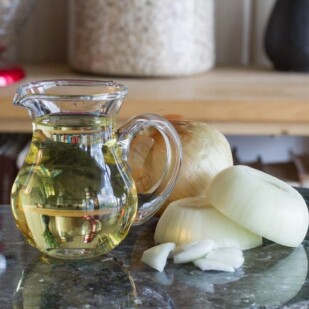We have New Orleans Style Low FODMAP Gumbo! Instead of the “holy trinity” of lots of onions, celery and bell peppers and also the inclusion of garlic and garlic-laden andouille sausage, we have re-configured our recipe to be low FODMAP and plant-based, using jackfruit for a meaty texture, and butter beans for protein. You can add low FODMAP sausage, too, if you like, plant-based or otherwise.

Plant Focused
You will note that while this recipe is based upon jackfruit and butter beans we have mentioned adding sausage, if you like. These could be plant-based sausages or meat based. It is your choice! Remember, eating plant-based is not the same as vegan or vegetarian.
Check out our main article, Eating Plant-Based on The Low FODMAP Diet. It is all about adding more plant-based ingredients to your diet, and this recipe is a perfect example, as the bulk of the ingredients are vegetable, fruit and beans.
Gumbo is a savory, spicy, meaty, thick, and deeply flavorful Southern stew, traditionally served atop a bed of white rice, topped with parsley, and spiced with a distinct Cajun creole seasoning blend.
The name “gumbo” originates from the Central Bantu West African word for okra. Much of the quintessential gumbo flavor comes from what’s called the “holy trinity” of Creole cooking: onions, celery, and bell peppers, with a hefty side of fresh garlic, andouille sausage, and seafood. So, when we were asked to make a plant-based low FODMAP version of this Louisiana classic, we were excited by the challenge!
There are two key components to a classic, New Orleans style gumbo: the texture, and the flavor. To achieve the thick texture of a traditional gumbo – without the FODMAPs – we opted to make a low FODMAP roux in addition to low FODMAP servings of chopped okra. Then, to hit that allium-rich Cajun creole flavor note, we busted out all the stops with low FODMAP onion and garlic swaps, including scallion greens, chives, leek tops, Low FODMAP Garlic-Infused Oil and asafetida.
A roux is a one-to-one combination of flour and fat cooked until very well browned and it is essential to any gumbo recipe! It will be thick, chocolatey-brown and also richly flavored. It is key to building your gumbo.
Roux, along with okra, is what gives gumbo its signature thick texture and depth of flavor, and the darker this roux, the deeper the flavor! You will want to make sure that you keep an eye on the roux and continuously whisk as it thickens and darkens to avoid burning – the flavor is so worth the additional effort.
In this recipe, we use a low FODMAP gluten-free all-purpose flour for the roux to accommodate more lucky diners, but you are free to use whichever flour suits your gluten tolerance. We also incorporate both asafetida and Low FODMAP Garlic-Infused Oil directly into the roux for that pungent kick we would otherwise get from garlic and onion. Please use an oil made from a neutral flavored oil and not olive oil; its flavor is not suitable for this recipe. I have chosen avocado, but you could use another neutral flavored oil.
Many traditional gumbo recipes use filé powder as a thickener and flavor agent. Filé is made from the North American sassafras tree (Sassafras albidum) and has not been lab tested for FODMAPs, so we did not include it in our recipe.
In this Low FODMAP Gumbo recipe, we use a combination of butter beans, chopped oyster mushrooms, and shredded jackfruit for a touch of meaty texture – but this is really where you can get creative with your favorite plant-based protein, sausage, and seafood swaps based on your tolerance and preferences.
Butter beans are low FODMAP in ¼ cup (35 g) or less and are rich in prebiotic fibers, magnesium, and plant-based proteins. Jackfruit packs a similar nutrient profile, with more fiber and protein than most fruit (more on this below). Oyster mushrooms act as a great substitute for chicken in many plant-based recipes, as they take on a similar texture and mouthfeel and easily absorb surrounding flavors.
Jackfruit is native to southwest India and has spread throughout the region to grow abundantly in Indonesia, Malaysia, Thailand, the Philippines, and beyond. Eaten ripe and raw, it has a mild sweet taste like pineapple; cooked and unripe, it has a starchier, potato-like consistency and a neutral taste that easily absorbs surrounding flavors and seasonings.
You can find fresh jackfruit in some specialty stores (raw, ripe is my favorite way to eat it), but if you’re looking to swap shredded meat for jackfruit like for this gumbo recipe, go for canned young jackfruit instead.
As of 12/21 Monash University published lab test results for canned, drained, young jackfruit, which is what we call for in this recipe. They report that this type of jackfruit only contains trace amounts of FODMAPs and they set a serving size at ½ cup (100 g).
With the right amount of moisture and seasoning, young jackfruit can make for a delicious, fiber-rich, plant-based swap for shredded beef, pork, or chicken. This versatile fruit has been consumed in tropical regions around the world for millennia before making its way to the U.S. fairly recently as a trendy “new” ingredient.
Rinse, drain and remove and discard the seed pods. You can then shred and season. Be prepared to be blown away by this plant-powered shredded meat swap. I have actually had meat-eaters tell me that the jackfruit in this recipe tastes exactly like shredded chicken – try and see for yourself!
Jackfruit is much lower in protein than poultry or meat, so when it is presented as a meat swap, it is mostly texture that we are addressing.
Making Gumbo
For the Roux: Add oil to a 10-quart (9.5 L) stock pot set over medium heat. When oil is shimmering whisk in asafetida then whisk in flour.
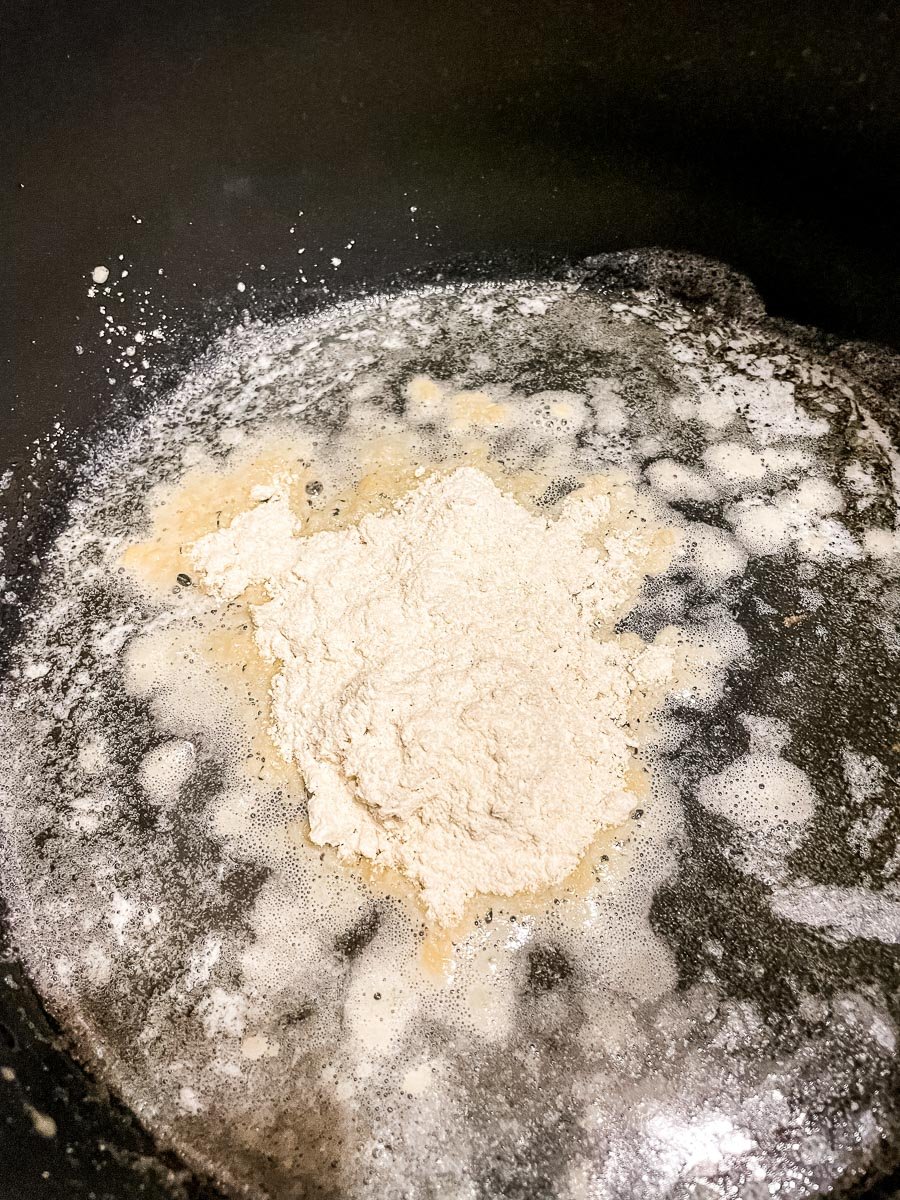
Continue whisking for several minutes, or until the roux becomes a rich brown, milk chocolate color. Do not leave your roux unattended or it may burn!
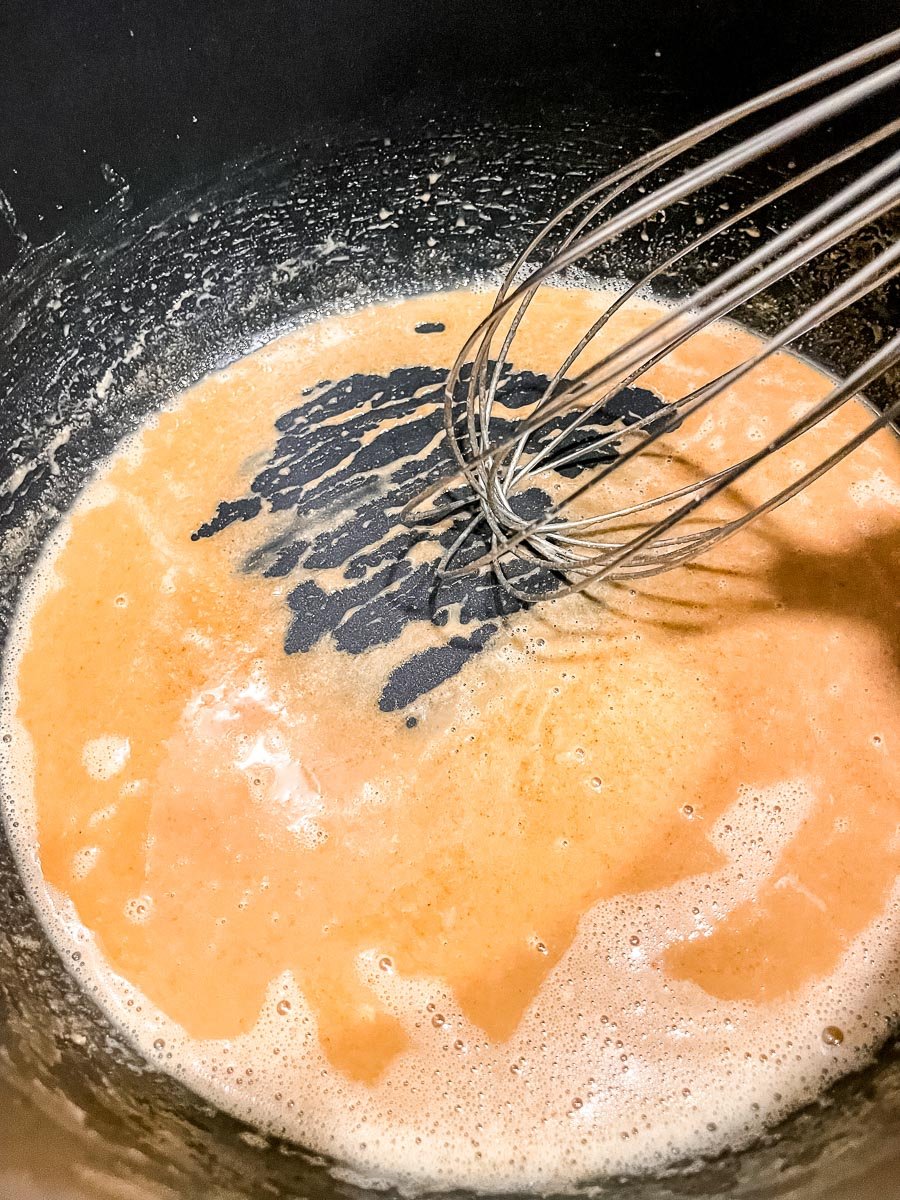
For the Gumbo: Once the roux is a rich milk chocolate color, whisk in the tomato paste, miso, chives, green peppers, leeks, scallions and celery until well combined.
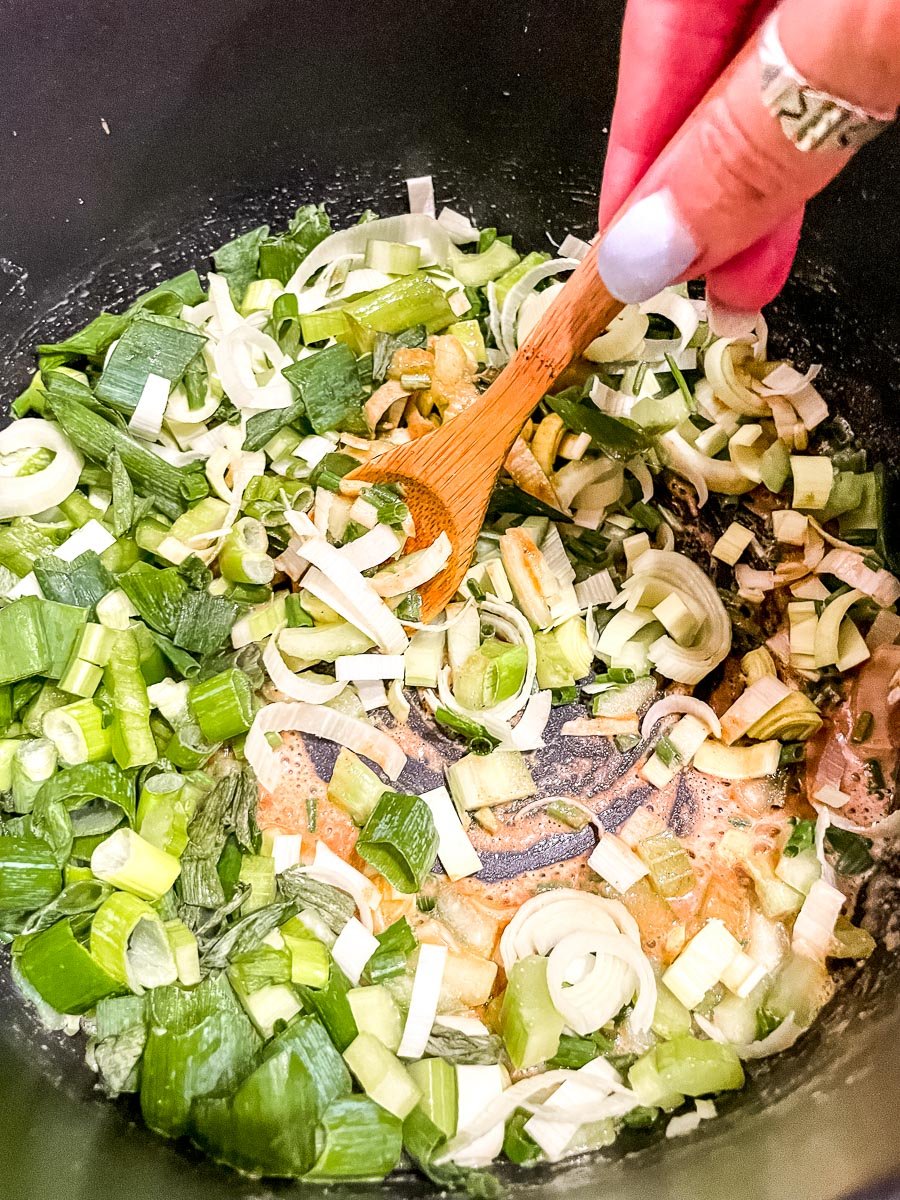
Continue to cook, whisking/stirring frequently until vegetables soften, about 4 minutes.
While the greens are softening, prepare your Cajun creole seasoning by combining smoked paprika, basil, oregano, thyme, black pepper, salt, white pepper and cayenne together in a small bowl; set aside.
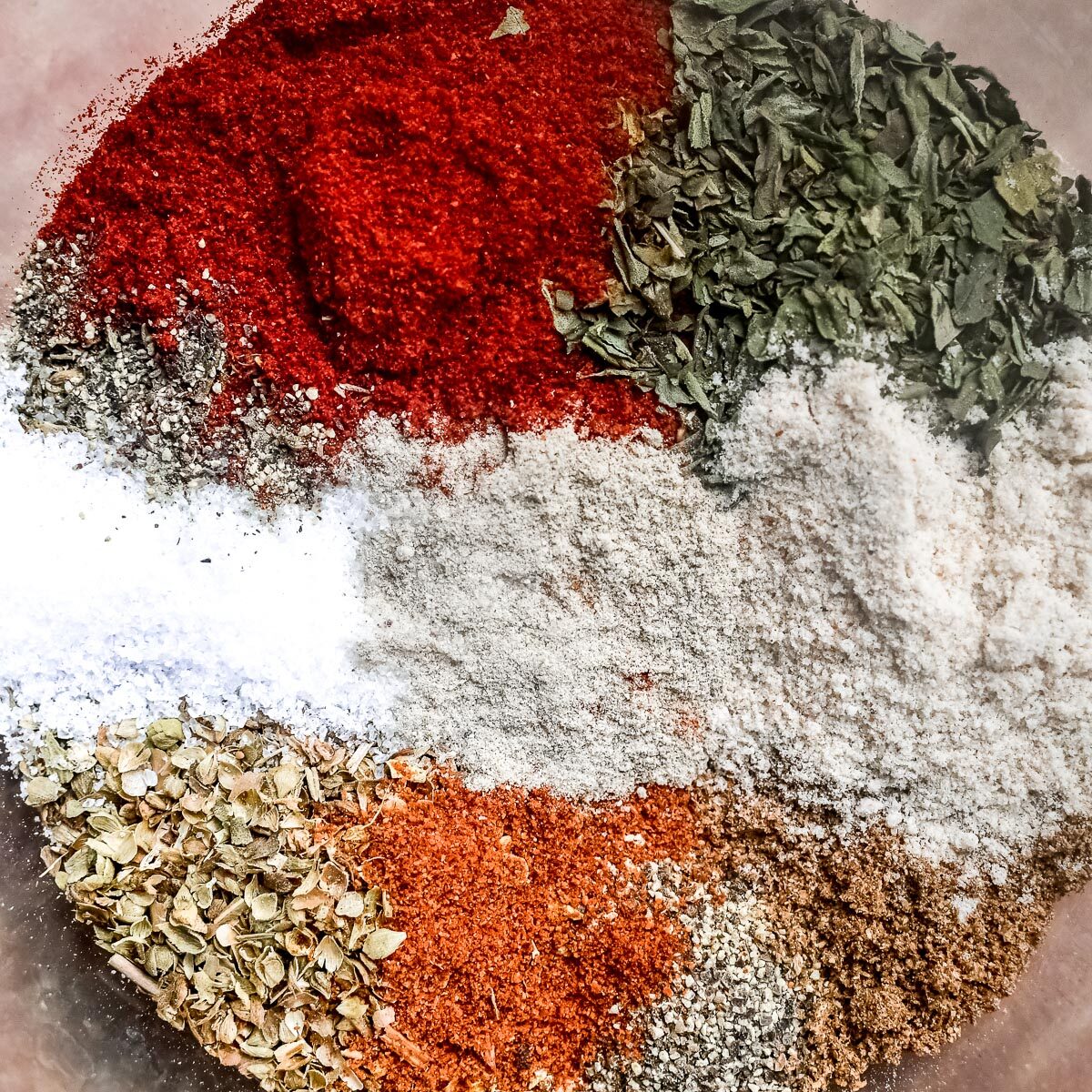
Add jackfruit, okra, oyster mushrooms and okra to your cooked mixture, stirring in well to incorporate.
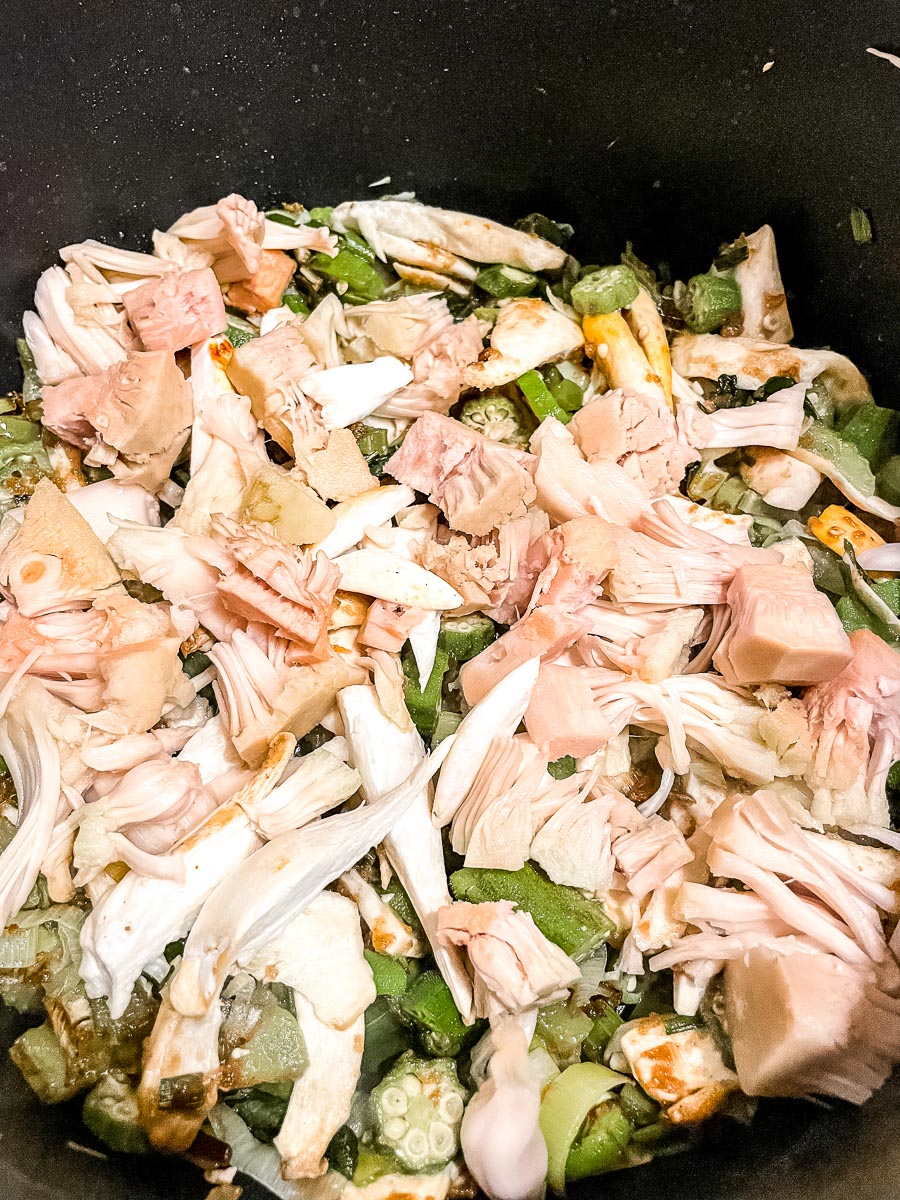
Add Cajun creole seasoning to mixture and stir until everything is thoroughly combined.
Stir in 3-cups (720 ml) vegetable broth, the fire roasted tomatoes, white vinegar, sugar, and bay leaves. Note: you may also add sausage or plant-based sausage at this stage depending on your preference and tolerance. Gently stir in the butter beans. Cover and a adjust heat to a low simmer.
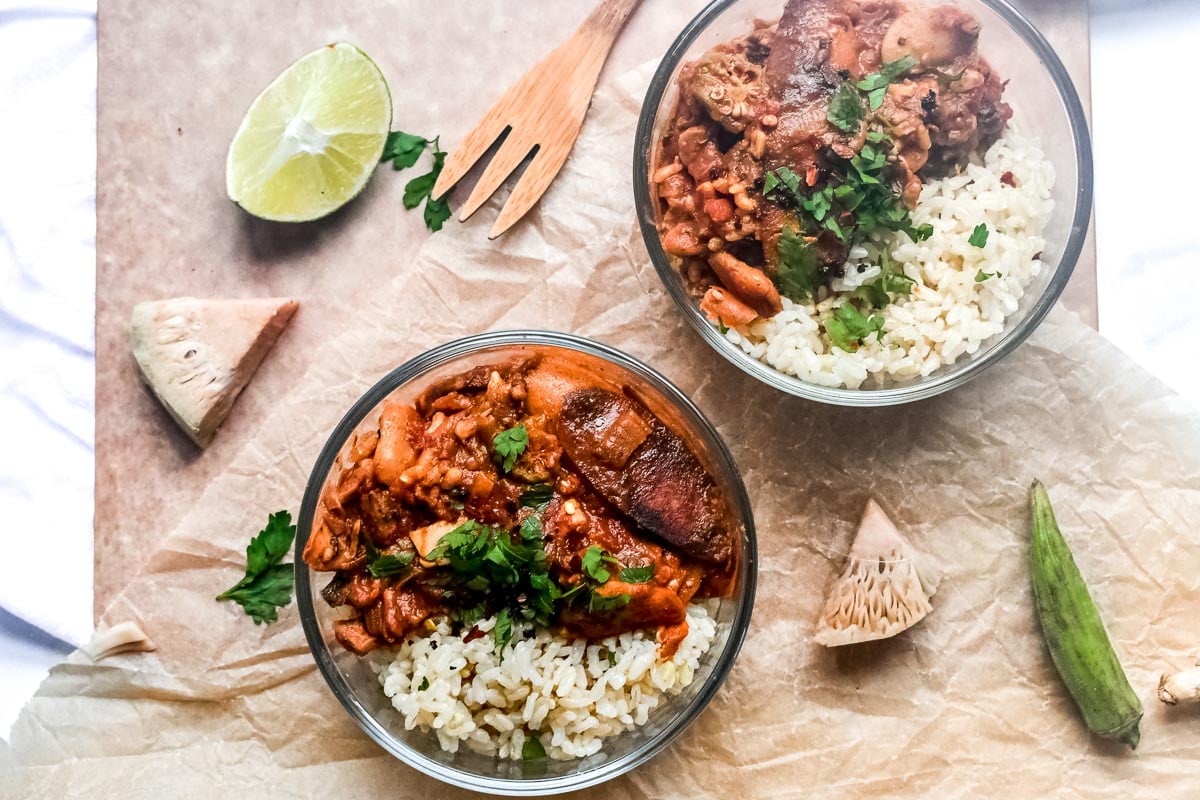
Simmer for 60 minutes minimum, stirring occasionally. Add additional low FODMAP broth as needed to achieve your desired gumbo consistency. More liquid will make a thinner gumbo. Taste and adjust seasoning, adding hot sauce, if you like, or offer hot sauce at the table. We like our gumbo served with rice, garnished with parsley. Leftovers can be refrigerated in an airtight container for 3 days.
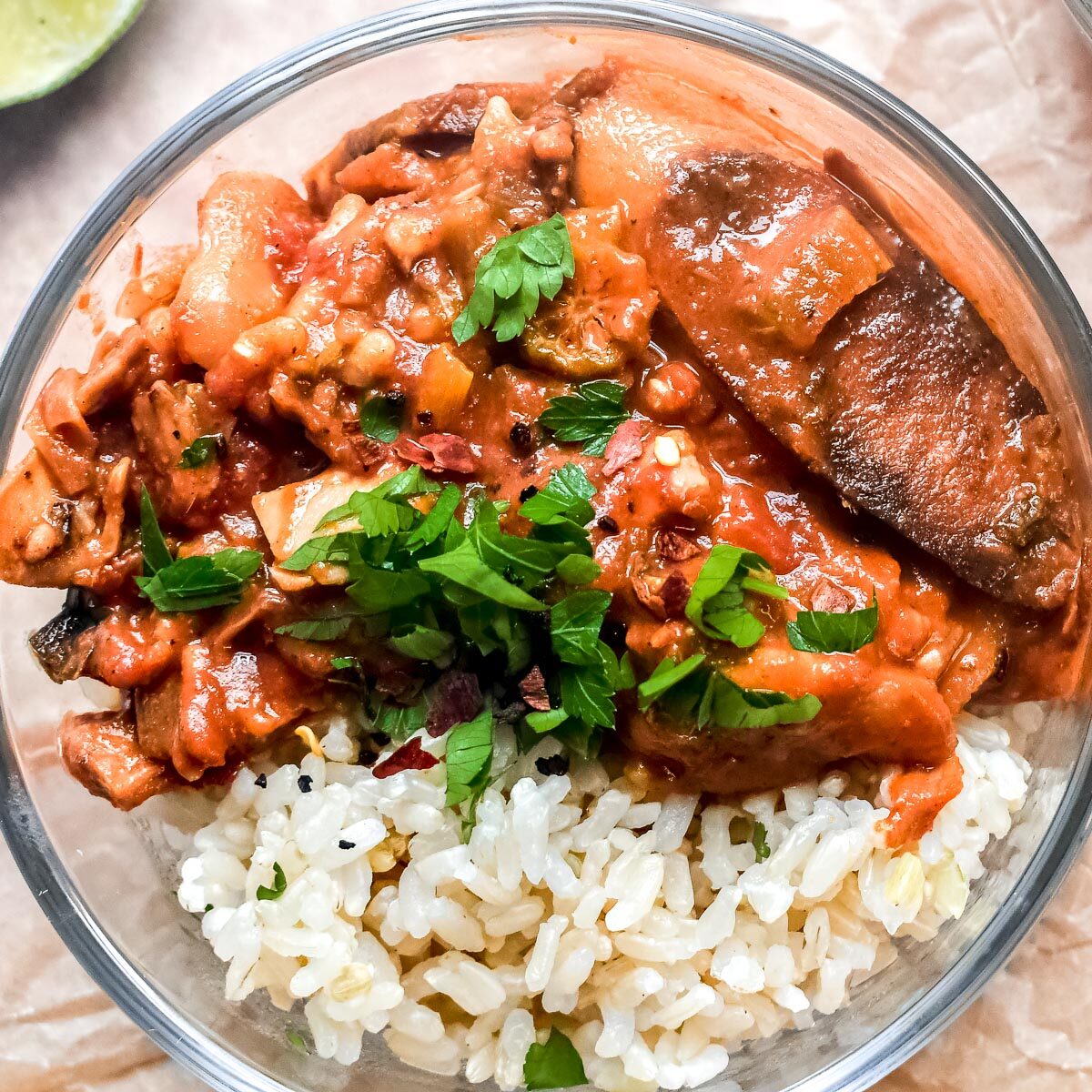
FODMAP Information
Our recipes are based on Monash University and FODMAP Friendly science.
- Butter Beans: Monash University has lab tested canned butter beans and they are low FODMAP in ¼ cup (35 g) servings.
- Canned Tomatoes: Monash University has lab tested canned tomatoes and they are low FODMAP at 92 g or 3.2-ounces, which they say is about ⅗ of a cup. Moderate FODMAPs kick in at about ¾ cup or 115 g, at which point fructose can become an issue.
- Celery: Celery it has been lab tested by both Monash University and FODMAP Friendly. Monash University has lab tested celery and it is low FODMAP in 10 g amounts, which is about a quarter of an average stalk per serving. FODMAP Friendly gives it a “Pass” at 75 g or ¾ cup.
- Chives: Both Monash University and FODMAP Friendly have lab tested chives. Monash says that chives contain no FODMAPs. FODMAP Friendly gives them a “Pass” at 1 tablespoon (4 g).
- Garlic-Infused Oil: Make your own Garlic-Infused Oil or buy a commercial equivalent for the easiest way to add garlic flavor to your food. Fructans in garlic are not oil-soluble, so garlic-infused oil is low FODMAP.
- Green Bell Peppers: Green bell peppers have been lab tested by Monash University and are recommended in low FODMAP amounts of ½ cup or 52 g. FODMAP Friendly has lab tested green bell peppers and states that 1 small pepper at 75 g is low FODMAP.
- Leeks: The green parts of leeks are low FODMAP as determined by Monash University lab testing and can be used to add onion flavor to your low FODMAP cooking. Monash also states that a combination of leek bulb and leek greens are low FODMAP in ½ cup (38 g) portions, but we do not know the ratio of bulb to greens.
- Scallions: The green parts of scallions are low FODMAP as determined by Monash University lab testing and can be used to add onion flavor to your low FODMAP cooking.
- Sugar: Monash University and FODMAP Friendly have both lab tested white, granulated sugar. Monash states that a Green Light low FODMAP serving size of white sugar is ¼ cup (50 g). FODMAP Friendly simply states that they have tested 1 tablespoon and that it is low FODMAP. Regular granulated white sugar is sucrose, which is a disaccharide made up of equal parts glucose and fructose. Sucrose is broken down and absorbed efficiently in the small intestine.
Please always refer to the Monash University & FODMAP Friendly smartphone apps for the most up-to-date lab tested information. As always, your tolerance is what counts; please eat accordingly. The ultimate goal of the low FODMAP diet is to eat as broadly as possible, without triggering symptoms, for the healthiest microbiome.
Looking for vegetarian breakfasts? Check out this article, with our favorites.
And for more plant-forward recipes in general, check out Plant Power: 31 Low FODMAP Vegan and Plant-Based Recipes.

New Orleans Style Low FODMAP Gumbo
We have New Orleans Style Low FODMAP Gumbo! Instead of the “holy trinity” of lots of onions, celery and bell peppers and also the inclusion of garlic and garlic-laden andouille sausage, we have re-configured our recipe to be low FODMAP and plant-based, using jackfruit for a meaty texture and butter beans for added protein. You can add low FODMAP sausage, too, if you like.
Ingredients:
For the Roux:
- ¼ cup (60 ml) Low FODMAP Garlic-Infused Oil, preferably made with avocado oil or other neutral flavored oil; not olive oil
- 1 teaspoon asafetida; use gluten-free if following a gluten-free diet
- ¼ cup (36 g) low FODMAP gluten-free all-purpose flour
For the Gumbo:
- 2 tablespoons tomato paste
- 1 tablespoon red miso paste
- 1 cup (64 g) chopped chives
- 1 cup (104 g) diced green bell pepper
- 1 cup (72 g) finely chopped leeks, green parts only
- 1 cup (64 g) chopped scallions, green parts only
- ½ cup (38 g) chopped celery
- 3 tablespoons smoked paprika
- 1 tablespoon dried basil
- 1 tablespoon dried oregano
- 2 teaspoon dried thyme
- 1 teaspoon black pepper
- 1 teaspoon salt
- 1 teaspoon white pepper
- 1/4 teaspoon cayenne
- 1 cup (75 g) rinsed, shredded, canned jackfruit,
- 1 cup (75 g) chopped trimmed oyster mushrooms
- 20 pods (200 okra, chopped
- 3 cups (720 ml) Low FODMAP Vegetable Broth, plus extra as needed
- 1, 14.5-ounce (411 g) can fire roasted diced tomatoes
- 1 tablespoon white vinegar
- 1 teaspoon sugar
- 2 bay leaves
- 1 cup (139 g) rinsed, drained, canned butter beans
- Chopped flat-leaf parsley
Optional Additions (to taste):
- Low FODMAP hot sauce, such as Tabasco
- Low FODMAP sausage, meat, poultry, plant-based or vegan
Preparation:
-
For the Roux: Add oil to a 10-quart (9.5 L) stock pot set over medium heat. When oil is shimmering whisk in asafetida then whisk in flour. Continue whisking for several minutes, or until the roux becomes a rich brown, milk chocolate color. Do not leave your roux unattended or it may burn!
-
For the Gumbo: Once the roux is a rich milk chocolate color, whisk in the tomato paste, miso, chives, green peppers, leeks, scallions and celery until well combined. Continue to cook, whisking/stirring frequently until vegetables soften, about 4 minutes.
-
While the greens are softening, prepare your Cajun creole seasoning by combining smoked paprika, basil, oregano, thyme, black pepper, salt, white pepper and cayenne together in a small bowl; set aside.
-
Add jackfruit, okra, oyster mushrooms and okra to your cooked mixture, stirring in well to incorporate. Add Cajun creole seasoning to mixture and stir until everything is thoroughly combined.
-
Stir in 3-cups (720 ml) vegetable broth, the fire roasted tomatoes, white vinegar, sugar, and bay leaves. Note: you may also add sausage or plant-based sausage at this stage depending on your preference and tolerance. Gently stir in the butter beans. Cover and a adjust heat to a low simmer.
-
Simmer for 60 minutes minimum, stirring occasionally. Add additional low FODMAP broth as needed to achieve your desired gumbo consistency. More liquid will make a thinner gumbo. Taste and adjust seasoning, adding hot sauce, if you like, or offer hot sauce at the table. We like our gumbo served with rice, garnished with parsley. Leftovers can be refrigerated in an airtight container for 3 days.
Notes:
FODMAP Information
Our recipes are based on Monash University and FODMAP Friendly science.
• Butter Beans: Monash University has lab tested canned butter beans and they are low FODMAP in ¼ cup (35 g) servings.
• Canned Tomatoes: Monash University has lab tested canned tomatoes and they are low FODMAP at 92 g or 3.2-ounces, which they say is about ⅗ of a cup. Moderate FODMAPs kick in at about ¾ cup or 115 g, at which point fructose can become an issue.
• Celery: Celery it has been lab tested by both Monash University and FODMAP Friendly. Monash University has lab tested celery and it is low FODMAP in 10 g amounts, which is about a quarter of an average stalk per serving. FODMAP Friendly gives it a “Pass” at 75 g or ¾ cup.
• Chives: Both Monash University and FODMAP Friendly have lab tested chives. Monash says that chives contain no FODMAPs. FODMAP Friendly gives them a “Pass” at 1 tablespoon (4 g).
• Garlic-Infused Oil: Make your own Garlic-Infused Oil or buy a commercial equivalent for the easiest way to add garlic flavor to your food. Fructans in garlic are not oil-soluble, so garlic-infused oil is low FODMAP.
• Green Bell Peppers: Green bell peppers have been lab tested by Monash University and are recommended in low FODMAP amounts of ½ cup or 52 g. FODMAP Friendly has lab tested green bell peppers and states that 1 small pepper at 75 g is low FODMAP.
• Leeks: The green parts of leeks are low FODMAP as determined by Monash University lab testing and can be used to add onion flavor to your low FODMAP cooking. Monash also states that a combination of leek bulb and leek greens are low FODMAP in ½ cup (38 g) portions, but we do not know the ratio of bulb to greens.
• Scallions: The green parts of scallions are low FODMAP as determined by Monash University lab testing and can be used to add onion flavor to your low FODMAP cooking.
• Sugar: Monash University and FODMAP Friendly have both lab tested white, granulated sugar. Monash states that a Green Light low FODMAP serving size of white sugar is ¼ cup (50 g). FODMAP Friendly simply states that they have tested 1 tablespoon and that it is low FODMAP. Regular granulated white sugar is sucrose, which is a disaccharide made up of equal parts glucose and fructose. Sucrose is broken down and absorbed efficiently in the small intestine.
Please always refer to the Monash University & FODMAP Friendly smartphone apps for the most up-to-date lab tested information. As always, your tolerance is what counts; please eat accordingly. The ultimate goal of the low FODMAP diet is to eat as broadly as possible, without triggering symptoms, for the healthiest microbiome.
Nutrition
All nutritional information is based on third-party calculations and should be considered estimates. Actual nutritional content will vary with brands used, measuring methods, portion sizes and more. For a more detailed explanation, please read our article Understanding The Nutrition Panel Within Our Recipes.

